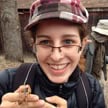-
Asked by 492hyda27 to Zoe, Avani, Jeff, Kenzi, Lindsay on 17 May 2015. This question was also asked by PJ.0
-
Zoe GetmanPickering answered on 17 May 2015:
I have only been a graduate student for 1 year so I haven’t done too much yet.
I did discover that an invasive weed (a plant that people accidentally brought over from the middle east and which started taking over parts of California) was evolving super quickly to suck up all the nutrients and grow faster than native plants.
I took seeds from the middle east and from California and grew them in a greenhouse with native plants. I found that the seeds from California grew up and took over the pots, while the ones from the middle east didn’t take over. This means that, for the last few decades this plant has been evolving to be more aggressive in the US.I used to work as part of a research team in a bumble bee lab. Did you know that plant nectar is full of sugar but it also has some poisons too? The team found out that the bees were drinking the nectar as medicine when they were sick. The poison didn’t hurt them, but it did hurt parasites that live in their stomach (the bee equivalent of tape worms). I didn’t come up with this project myself, I just helped out. We found out which poisons were in the nectar naturally and copied it to make our own nectar with sugar water. We had bees that were infected and we fed them the sugar water with the poisons. Some bees were only fed sugar water. The bees that got a little bit of the poison in their nectar had less parasites and were healthier than the ones that got plain old sugar water. I had to do a lot of boring things, like counting parasites under a microscope for hours, but it was totally worth it.
-
-
K. Lindsay Hunter answered on 19 May 2015:
The most amazing discovery that I’ve been a part of is Rising Star Expedition, where we excavated over a thousand fossils of a new kind of fossil human ancestor! The fossils were discovered by recreational cavers (one of them is now my husband!) who were exploring caves in the area for a professor named Lee Berger, who hypothesized that the caves in the Cradle of Humankind (which are known to contain hominin fossils) haven’t been fully explored or excavated—and he was right! A lot of what we’re doing now is exploring other caves in the area, as well as trying to figure out why the fossils ended up in this cave in the first place. That last is a hard one, bc individuals of all ages and both sexes were found in an area that isn’t very accessible now and doesn’t seem to have been more open in the past. Often, when we find big accumulations of bones like this, they’re the result of carnivore or scavenger, they fell in accidentally, or they were buried. It doesn’t seem to be the first two and the last one doesn’t make sense, since it’s very far away from any light and hard to find even WITH an artificial light, like we have.
So, what do you think? Do you think they were all early explorers that got lost? Were they hiding or living deep in this cave? How did they get around? How did they die? These are all amazing questions that my brain is busy working on right now, so hopefully, I’ll have something amazing to test in the future!
-
Jeff Shi answered on 20 May 2015:
Every day I’m making more amazing discoveries about bats. So far, the most exciting thing I’ve learned and published – that’s a scientist’s way of letting everyone know! – is that bats have been evolving in a really bizarre way that’s different than all other mammals. Most other groups of mammals have some small groups that evolve faster than others, but bats seeem to ALL be evolving very quickly!






Comments